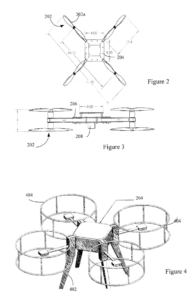By Cody Andrushko (Syracuse College of Law Class of 2019)
Drones (also known as Unmanned Aircraft Systems (“UAS”)) are currently a subject of controversy within the United States and globally due to the potential safety, security, and privacy threats that people face when exposed to them. Currently, drones are operated both for recreational and commercial purposes.
Tethered drones, a hybrid field of drones, have recently seen new innovation and implementation. Companies, such as Fotokite, who recently was awarded one million dollars in the GENIUS NY business accelerator competition, have made great strides in the field. Sergei Lupashin, CTO and Founder of Fotokite, is among a group of inventors that have developed a patented (United States Patent 9,753,355 B2) flight control process that enables kite-like operation for tethered drones.

Tethered drones, as opposed to free-flying drones, have potentially three significant advantages: (1) power, (2) security, and (3) control.
Having the device tethered has allowed companies to develop drones that can be continually powered for prolonged operation. As a result, tethered drone devices and services have seen recent marketing to municipal governments for implementation within police forces and fire departments. Tethered drones often offer better vantage points and larger perspectives than current tools used, which enables first responders to better assess quickly evolving and often-dangerous situations, where information saves lives. Drone cameras can be outfitted with an array of sensors, which can enable tethered drones to be tailored to particular market sectors, such as infrared cameras for fire departments.
Tethered drones have seen practical application by the secret service that is operating an undisclosed model of the tethered drone while protecting President Trump. Tethered drones will likely see larger implementation for security purposes in the future, as they are often: portable; designed for quick set-up; able to provide aerial imaging (for often larger and better perspectives); enabled to operate for a long period of time per mission; and incorporated with video feed and control software that can be hardwired via tether between drone and operator, which enables more secure operation.
Further, the tether enables operators to have more control over the device. While the drone still has a radius of movement, the tether enables more control when unforeseen weather or operational issues occur because it is still limited by the amount of tether provided.
While some people seek to avoid UAS regulations by tethering their drone and arguing that it is more akin to a balloon or kite, than a drone, the FAA does not agree. The FAA addressed this issue in a recent document [Docket No.: FAA-2015-0150], “…a small unmanned aircraft that uses powered systems for actions such as propulsion or steering is not a balloon or kite subject to part 101” and further states that “the definition of small UAS in this rule includes tethered powered small UAS.”
Further, on October 5, 2018, President Trump signed the FAA Reauthorization Act of 2018, which sought to define a class of tethered drones: “actively tethered unmanned aircraft system.” However, this only included tethered drones that “weighs 4.4 pounds or less, including payload but not including the tether; (B) is physically attached to a ground station with a taut, appropriately load-rated tether that provides continuous power to the unmanned aircraft and is unlikely to be separated from the unmanned aircraft; and (C) is controlled and retrieved by such ground station through physical manipulation of the tether.” Tethered drones that meet these conditions will be regulated similar to other drones, requiring that the drone give way to other aircraft; fly within a 150 feet from ground level; and within visual line of site of operator, among other conditions.
Drone operators and manufacturers will continue to innovate and explore this new technological field. The government will need to remain active and involved to ensure regulations can meet the ever-present progress of people and improve so that progress is not impeded.
